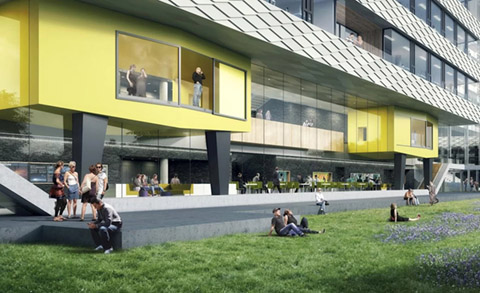
Promoting creativity & chance encounters
How to build the ideal campus
The scientist heads out into the cold, the autumn wind blasting in her face. She hops on the wet saddle of her bike and pedals as quickly as she can past closed cafés and bars. She makes eye contact with a few strangers, but doesn’t say hello. When she arrives at her destination, she parks her bike and rushes into the lab, her back all sweaty.
This is her daily routine: she moves around campus constantly, on her way to the next class to teach, the next experiment to conduct, as quickly and efficiently as possible.
Sound familiar?
It shouldn’t, says spatial planning and environment researcher Isabelle Soares. The spaces outside of the labs and lecture halls should be where you find inspiration and meet new people. The pavement between the buildings should be ‘an interface for creativity’, she argues. Not a place to smoke. ‘Active mobility, such as walking and cycling, is not just A to B movement, but an experience of which public spaces are a fundamental part.’
Ideal campus
Her ideal campus is a mix of meeting places and diverging paths, with opportunities to sit, and trees and ponds throughout the area. A public space in which residents, students, and professors can share knowledge and skills, or just relax.
Everyone is creative, but sometimes you just need a hand
Then there are the semi-open spaces, where people come together outside of work and home, like cafes, sports complexes, and restaurants. On Soares’ ideal campus, these are scattered everywhere, because it’s important that people can have a good talk over a cup of coffee anytime they want to.
Soares should know, because she has been studying university campuses for some time now. She wants to know how the built environment on a campus can enhance its users’ creativity. ‘You can only promote encounters between people if you provide a suitable space for them to share knowledge and exchange ideas’, she says. ‘Everyone is creative, but sometimes you just need a hand.’
Modernistic masterplan
Careful urban planning and optimal use of mobility can provide that little bit of help. Of course Soares working on a campus made it convenient for her to focus her research on campus spaces, ‘but what motivated me was the real-life problem of Zernike and the use of the public spaces here’, she says.
Soares recently published an article on boosting creative encounters on the campuses and science parks of Amsterdam and Utrecht. But before that, she wanted to know where people interacted most: in the inner cities where small buildings are scattered around the city centre, or in the almost industrial science parks at the edges of town?
The old Dutch university campuses have grown in a natural fashion, Soares noticed. ‘They just weave through the city centre’, she says. ‘All buildings are within walking distance of each other.’
Science parks, on the other hand, are ‘usually top-down modernistic masterplans, designed with the car in mind’. Wide lanes cover large surface areas. Educational buildings, commercial companies, and local residents are all separated from each other.
Stick to one area
Soares built a tool to analyse the frequency of ‘creative encounters’ in campuses’ public spaces, comparing the city-centre campus and science parks.
When I was walking around, people looked at me strangely
She had expected the city centres to be where people interact with each other most, but that turned out not to be the case. People tended to stick to their own area, she says, and only interacted with those familiar to them. ‘When I was walking around these university buildings for my research, people looked at me strangely’, Soares says.
The science parks, on the other hand, cover large areas that are well-suited to creative encounters. The spacious lay-out makes room for parks and resting places outside of the campus buildings. ‘The buildings very often have this open ground floor where people from multiple faculties can encounter each other’, Soares says.
Creative encounters
That is almost impossible in the city centres she studies. ‘Inner-city buildings are different. When you enter there, it’s as if you are invading a home. But if there was a place to share your knowledge with others, everybody would benefit greatly from it.’
So, how does Groningen rank? Is the UG a good place for these much-desired creative encounters?
‘The proximity between buildings is good’, Soares says. ‘For instance, in the centre you have the library and multiple other university buildings within walking distance, which makes it easy to go to class in different buildings.’ The same goes for the Zernike science park.
There’s not a lot of diversity of uses and that’s a problem
But the Groninger city-centre campus also lacks something: spaces for stationary activities. ‘I think that is an issue of dense European cities. Students here often sit on the Academy building stairs, because that’s almost the only option.’ Zernike on the other hand does have places where you can sit: the food court for instance, or the area surrounding the Duisenberg building.
Diversity
Zernike isn’t perfect either, though, Soares says. ‘Other parts are very car- and bike-oriented and the buildings are not really open to the public.’ Then there’s the fact that the campus is only used for teaching and research: there’s no housing. ‘There’s not a lot of diversity of use and that’s a problem.’
Does she have any other wishes for Zernike? Those wide roads should be redesigned, she feels. ‘The road on a campus should become a place to be, to meet.’